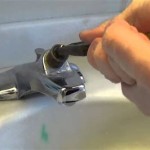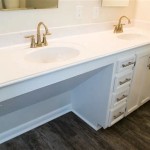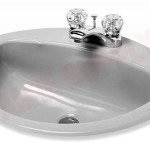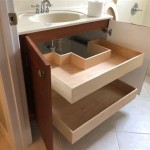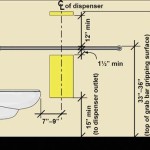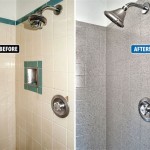How To Get Rid Of Mildew From Bathroom Ceiling
Mildew, a common household nuisance, frequently appears on bathroom ceilings due to the consistently humid environment. Addressing it promptly is essential, not only for aesthetic reasons, but also to prevent potential health issues and structural damage. This article provides a comprehensive guide on effectively removing mildew from bathroom ceilings, emphasizing preventative measures and long-term maintenance.
Mildew thrives in damp, poorly ventilated areas, making bathrooms an ideal breeding ground. Warm showers and baths generate considerable moisture, which, if not properly dissipated, condenses on surfaces like the ceiling. Over time, this moisture allows mildew spores, which are naturally present in the air, to germinate and spread.
Before commencing any cleaning procedure, it's crucial to differentiate between mildew and mold. While both are fungi, mildew typically appears as a surface growth, easily identifiable as flat spots, often white or gray, although it can sometimes be black. Mold, on the other hand, tends to penetrate deeper into materials and can be fuzzy, slimy, or discolored in various shades. If the growth appears to be more than surface-level mildew, professional mold remediation services are highly recommended.
Safety should always be the primary concern when dealing with any type of fungal growth. Adequate ventilation is paramount, and Personal Protective Equipment (PPE) should be worn to prevent inhalation of spores and skin contact with cleaning solutions. This includes wearing gloves, a mask covering the nose and mouth, and eye protection, such as goggles. Open windows and doors to ensure proper air circulation throughout the cleaning process. If the bathroom lacks a window, activate the exhaust fan and consider using a portable fan to further improve ventilation.
The effectiveness of mildew removal hinges on selecting appropriate cleaning solutions and applying them correctly. Several options are available, ranging from readily available household products to specialized mildew removers. The choice often depends on the severity of the mildew growth and the type of ceiling surface.
Preparing for Mildew Removal
Before applying any cleaning solution, preparation is key. The first step involves protecting the surrounding area. Cover the floor with drop cloths or plastic sheeting to prevent spills and staining. Remove any items that could be damaged by cleaning solutions, such as shower curtains, rugs, and toiletries. If possible, cover the shower or bathtub to shield it from splashes.
Dust or vacuum the ceiling to remove any loose debris or cobwebs. This allows the cleaning solution to directly target the mildew and prevents the spread of airborne particles during the cleaning process. A simple brush attachment on a vacuum cleaner can be used for this purpose.
Test the chosen cleaning solution on a small, inconspicuous area of the ceiling before applying it to the entire surface. This step is crucial to ensure that the solution does not damage or discolor the ceiling paint or material. Allow the test area to dry completely and observe any adverse reactions before proceeding.
Effective Cleaning Solutions
Several cleaning solutions can be used to effectively remove mildew from bathroom ceilings. Each solution has its own advantages and potential drawbacks, and the best choice will depend on individual preferences and the severity of the mildew problem. It is imperative to exercise caution and follow safety guidelines when working with any cleaning agent.
Bleach Solution: A mixture of bleach and water is a common and effective solution for killing mildew. The standard ratio is one part bleach to three parts water. Bleach is a powerful disinfectant and can effectively eliminate mildew spores. However, it is essential to use bleach with caution and to ensure proper ventilation, as it can release harmful fumes. Always wear gloves, eye protection, and a mask when working with bleach. Never mix bleach with ammonia or other cleaning agents, as this can create toxic gases.
Vinegar Solution: White vinegar is a natural and less harsh alternative to bleach. It is an effective disinfectant and can kill many types of mold and mildew. Vinegar can be used undiluted or mixed with water in a 1:1 ratio. While vinegar is generally considered safe, it can have a strong odor that may be unpleasant to some individuals. Ensure adequate ventilation when using vinegar.
Baking Soda Paste: Baking soda is a mild abrasive and a natural deodorizer that can help remove mildew stains and odors. Mix baking soda with a small amount of water to create a paste. Apply the paste to the mildewed areas, let it sit for a few minutes, and then scrub gently with a soft brush or sponge. Rinse thoroughly with water.
Commercial Mildew Removers: Several commercially available mildew removers are specifically formulated for bathroom surfaces. These products often contain stronger chemicals than household solutions and may be more effective for stubborn mildew growth. Always read and follow the manufacturer's instructions carefully when using commercial mildew removers. Wear appropriate protective gear, including gloves, eye protection, and a mask, and ensure adequate ventilation.
The Cleaning Process
Once the area is prepared and the cleaning solution is selected, the actual cleaning process can begin. The following steps outline a general approach to removing mildew from bathroom ceilings:
Apply the Cleaning Solution: Using a sponge, cloth, or spray bottle, apply the chosen cleaning solution to the mildewed areas of the ceiling. Ensure that the solution is evenly distributed and that the mildewed areas are thoroughly saturated. Avoid oversaturating the ceiling, as this can cause water damage.
Allow the Solution to Dwell: Allow the cleaning solution to dwell on the surface for a specified period of time, typically 10 to 15 minutes. This allows the solution to penetrate the mildew and kill the spores. Do not allow the solution to dry completely on the surface.
Scrub the Surface: Using a soft brush, sponge, or cloth, gently scrub the mildewed areas of the ceiling. Avoid using abrasive scrubbers, as these can damage the paint or surface material. Scrub in a circular motion to loosen the mildew and remove stains. If the mildew is stubborn, repeat the application and scrubbing process.
Rinse Thoroughly: After scrubbing, rinse the ceiling thoroughly with clean water. Use a clean sponge or cloth to remove any remaining cleaning solution and mildew residue. Ensure that all traces of the cleaning solution are removed, as residual chemicals can cause discoloration or damage.
Dry the Ceiling: After rinsing, dry the ceiling thoroughly with a clean, dry cloth or towel. Use a fan or open a window to promote air circulation and speed up the drying process. Moisture remaining on the ceiling can encourage new mildew growth, so it is essential to ensure that the surface is completely dry.
Inspect and Repeat: After the ceiling is dry, inspect it carefully for any remaining mildew. If necessary, repeat the cleaning process to remove any stubborn stains or mildew growth. Once the ceiling is clean and dry, apply a mildew-resistant paint to help prevent future growth.
Preventative Measures for Long-Term Maintenance
Preventing mildew from returning is as important as removing it in the first place. Implementing preventative measures can significantly reduce the likelihood of future mildew growth and maintain a healthy bathroom environment.
Improve Ventilation: Proper ventilation is the most effective way to prevent mildew growth in bathrooms. Always use the exhaust fan during and after showers and baths to remove excess moisture from the air. If the bathroom lacks an exhaust fan, consider installing one. Opening a window after showering can also help to improve ventilation.
Reduce Humidity: Minimize humidity levels in the bathroom by addressing any leaks or water damage promptly. Repair leaky faucets, showerheads, and pipes to prevent water from accumulating. Consider using a dehumidifier in the bathroom to further reduce humidity levels.
Regular Cleaning: Regularly clean bathroom surfaces, including the ceiling, with a mildew-resistant cleaner. This will help to remove any mildew spores before they have a chance to grow. Wipe down wet surfaces after each use to prevent water from lingering.
Mildew-Resistant Paint: Apply a mildew-resistant paint to the bathroom ceiling. These paints contain additives that inhibit the growth of mildew. When repainting the bathroom, choose a paint specifically designed for high-humidity environments.
Proper Air Circulation: Ensure adequate air circulation throughout the bathroom. Avoid blocking air vents or placing items too close to the ceiling, as this can restrict airflow and create damp areas. Regularly clean air vents to remove dust and debris that can harbor mildew spores.
By implementing these preventative measures, homeowners can significantly reduce the risk of mildew growth in their bathrooms and maintain a clean, healthy environment for years to come.

Bathroom Ceiling Mold Removal When To Clean Call Branch Environmental

How To Remove Black Mold From A Bathroom Ceiling

Cleaning Mold From Bathroom Ceilings Like A Pro Lovetoknow

What Is The Best Way To Remove Mold From Bathroom Ceiling

How To Get Rid Of Mold On Your Bathroom Ceiling Aqa

How Do You Remove Mold From Bathroom Textured Ceiling Hometalk

Don T Let Mould Take Over How To Remove It From Your Ceiling

Cleaning Mrs Hinch Fans Share Tips To Remove Ceiling Mould Express Co

Bathroom Mold How To Identify And Get Rid Of In Environix

Mold On Bathroom Ceiling Wipe Out With Diy Remedies
Related Posts
